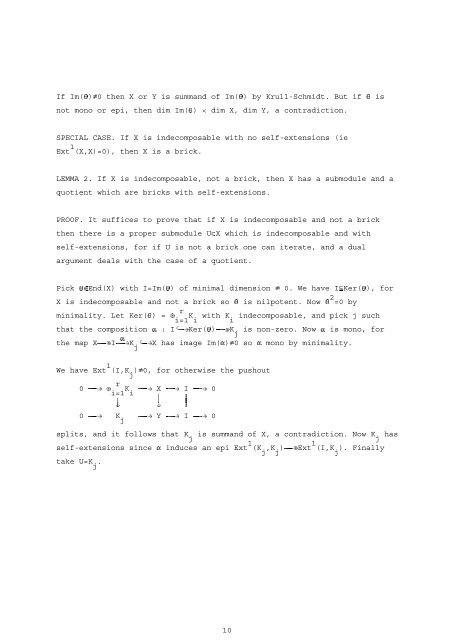Lectures on Representations of Quivers by William Crawley-Boevey ...
Lectures on Representations of Quivers by William Crawley-Boevey ...
Lectures on Representations of Quivers by William Crawley-Boevey ...
You also want an ePaper? Increase the reach of your titles
YUMPU automatically turns print PDFs into web optimized ePapers that Google loves.
If Im(¤ )£ 0 then X or Y is summand <strong>of</strong> Im(¤ ) <strong>by</strong> Krull-Schmidt. But if ¤ is<br />
not m<strong>on</strong>o or epi, then dim Im(¤ ) < dim X, dim Y, a c<strong>on</strong>tradicti<strong>on</strong>.<br />
SPECIAL CASE. If X is indecomposable with no self-extensi<strong>on</strong>s (ie<br />
1<br />
Ext (X,X)=0), then X is a brick.<br />
LEMMA 2. If X is indecomposable, not a brick, then X has a submodule and a<br />
quotient which are bricks with self-extensi<strong>on</strong>s.<br />
PROOF. It suffices to prove that if X is indecomposable and not a brick<br />
then there is a proper submodule U X which is indecomposable and with<br />
self-extensi<strong>on</strong>s, for if U is not a brick <strong>on</strong>e can iterate, and a dual<br />
argument deals with the case <strong>of</strong> a quotient.<br />
Pick ¤ ¡ End(X) with I=Im(¤ ) <strong>of</strong> minimal dimensi<strong>on</strong> £ 0. We have I Ker(¤ ), for<br />
2<br />
X is indecomposable and not a brick so ¤ is nilpotent. Now ¤ =0 <strong>by</strong><br />
r<br />
minimality. Let Ker(¤ ) = ¥ K with K indecomposable, and pick j such<br />
i=1 i i<br />
that the compositi<strong>on</strong> ¤ : I ¡ ¡ Ker(¤ ) ¢ K is n<strong>on</strong>-zero. Now ¤ is m<strong>on</strong>o, for<br />
the map X ¢ I ¡ K ¡ ¡ X has image Im(¤ )£ 0 so ¤ m<strong>on</strong>o <strong>by</strong> minimality.<br />
j<br />
)£<br />
¡ ¥ ¡ ¡ ¡<br />
1<br />
We have Ext (I,K 0, for otherwise the pushout<br />
j<br />
0<br />
r<br />
K<br />
i=1 i<br />
X I 0<br />
¤<br />
¥ ¢<br />
¥<br />
¦ ¦<br />
¢<br />
0 ¡ K ¡ Y ¡ I ¡ 0<br />
j<br />
splits, and it follows that K is summand <strong>of</strong> X, a c<strong>on</strong>tradicti<strong>on</strong>. Now K has<br />
j j<br />
1 1<br />
self-extensi<strong>on</strong>s ¤ since induces an epi Ext (K ,K ¢ ) Ext (I,K ). Finally<br />
j j j<br />
take U=K .<br />
j<br />
10<br />
j

















